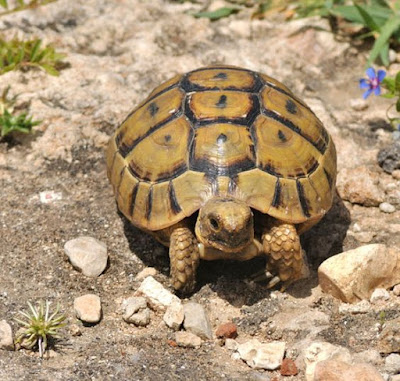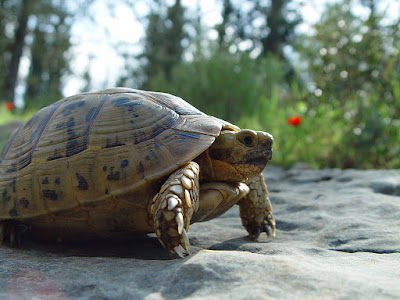Greek tortoises are found all through the Mediterranean from
Spain to Russia. Their normal living space shifts and they can be found in open
backwoods, fields, and deserts. Southern California is fundamentally the same
as their local atmosphere and these tortoises will do well if kept outside.
Vast winged animals, for example, crows can execute youthful tortoises so it's
best to keep hatchings inside. Greek tortoises remain genuinely little and once
in a while surpass eight inches. Guys are littler than females and grown-up
guys have a perceptibly longer tail. Captive breeding is common and females
will lay 2-8 eggs that incubate inside 80 days.
Name: Testudo graeca, Spur-thighed tortoise, Greek tortoise
Lifespan: Up to 50 years or more
Taxonomy
- Class: Reptilia
- Order: Chelonia/Testudines
- Family: Testudinidae
- Genus: Testudo
Taxonomy of spur-thighed tortoises has been in a condition
of transition for a considerable length of time. A few sources utilize the
names "spur-thighed tortoise" and "Greek tortoise"
reciprocally, anyway Mader (2006) recognized the spur-thighed tortoise as
Testudo graeca ibera. Chitty (2013) demonstrates that Mediterranean
spur-thighed tortoise and Greek spur-thighed tortoise are separate species out
and out. An examination distributed in Chelonian Conservation and Biology
(2012) alluded to Testudo graeca ibera as the Eurasian spur-thighed tortoise.
Size
These tortoises are regularly a little to medium estimated
creature with some exemptions. Contingent upon subspecies, they will develop to
in the vicinity of 5 and 8". A few cases of T. g. ibera will achieve
substantial measurements, for example, 10-11", however this is uncommon.
Guys are observed to be the littler of the genders however once more, there are
special cases. At bring forth, most Greek tortoises are close to an inch long.
They can develop quickly when over bolstered and reports of them achieving
4" in under two years is normal however not prescribed.
Appearance
Since there are such a large number of subspecies of the
Greek Tortoise, the appearance fluctuates broadly. Shading can extend from
olive with dim spots amidst every scute to a brilliant assortment that is all
yellow in shading. In all subspecies, the male is littler than the female.
Food and Water
Tortoises are herbivores. Quite a while back tortoise
proprietors would encourage their pets canned feline and pooch sustenance to
influence them to become speedier. In any case, it has since been found that an
eating regimen high in protein is unsafe to tortoises; an eating routine low in
protein and high in fiber is substantially more advantageous than nourishment
implied for carnivores. An assortment of dull, verdant greens, for example,
collard greens, endive, new parsley, and dandelion greens ought to be the
greater part of your tortoise's eating routine.
 Timothy roughage that is cleaved ought to be added to keep
your tortoise's bill trimmed and for the extra fiber.
Timothy roughage that is cleaved ought to be added to keep
your tortoise's bill trimmed and for the extra fiber.
Little measures of natural products, for example, cleaved
raspberries, strawberries, or apples might be included yet ought not to make up
in excess of 10 percent of the eating regimen. Some tortoise proprietors offer
a little measure of gut-stacked crickets and mealworms, however it isn't
essential.
General cleaning with calcium powder on the veggies is
prescribed to ensure your tortoise is getting enough calcium too.
Behavior and Temperament
Greek tortoises, in the same way as other reptiles, lean
toward not to be taken care of by people. Bigger tortoise assortments may even
nibble if got. Dealing with is exceptionally unpleasant for tortoises, and it
can negatively affect their wellbeing. Generally, Greek tortoises are affable
and smooth animals if their necessities are met and their repugnance for taking
care of is regarded.
Housing
In light of their narrow mindedness for a high mugginess
level, Greek Tortoises are one of a few tortoise species that really improve
the situation when housed inside. Be that as it may, you should even now set up
an outside pen for quite a long time when the climate is warm, dry, and not
muggy.
Glass aquariums are not prescribed for Greek Tortoises since
they don't take into account appropriate air dissemination. Plastic garden
lakes, swimming pools, and turtle tables are on the whole appropriate nooks. A
screened-in terrarium can likewise be utilized.
In the nook, you should give conceal detect that is at the
contrary end from the relaxing territory. It can be produced using rocks, wood,
or plastic holders, or you can buy a monetarily influenced stow away to spot.
Place a water dish in the fenced in area for drinking and splashing. Make
certain to utilize a shallow dish, as Greek Tortoises can't swim, and they will
suffocate in a profound dish that they can't without much of a stretch escape.
Reproduction and Breeding
Male Greek tortoises will show an exemplary conduct of
"shell slamming" in that they utilize their carapaces to pummel into
the females keeping in mind the end goal to cajole them into reproducing. Once
the female submits to the male's advances (he likewise violently chomps at her
legs and face) he will mount her from behind and start lovemaking. A
progression of shrill squeaks are ousted from the male's mouth as he stands out
his tongue amid the mating procedure. This demonstration of romance by and
large happens in April and May with egg laying beginning in June. The female
burrows a 4 to 7" jar formed settling chamber with her rear legs and
stores somewhere in the range of 3 to 6 eggs however now and then all the more
relying upon the subspecies. She at that point covers the home and leaves the
eggs to incubate without anyone else. I like to uncover the eggs and place them
in manufactured brooding. They are set in shut store glass holders on
marginally soaked vermiculite and are hatched at in the vicinity of 84 and 88F.
The higher temperature will bring about females, the lower in guys. At in the
vicinity of 55 and 70 days, the infant tortoises will incubate. They are left
inside the compartments in the hatchery until the point when they rectify and
assimilate their yolk sacs. They are then set in their raising fenced in areas
for the initial couple of years of life.



















No comments:
Post a Comment